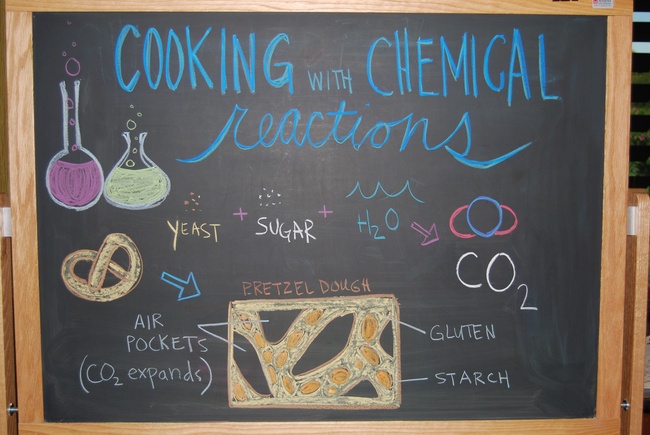Kitchen Science: Soft Pretzels – Chemical Reactions: Biological Leaveners in Baking

Summary
In this 8th grade science lesson, students prepare Soft Pretzels. While the pretzels bake in the oven, students activate yeast and observe the production of carbon dioxide, which causes the Soft Pretzels to rise.
Objectives
After this lesson, students will be able to:
- Identify characteristics of chemical and physical changes
- Recognize yeast as a living organism
- Know that yeast metabolizes sugar and releases CO2 (carbon dioxide) which causes bread to rise
Assessments
During this lesson, students will:
- Make observations and look for evidence of chemical and physical changes
- Activate yeast using warm water and sugar
- Identify yeast as a biological leavener that, when activated, produces CO2 and causes bread to rise
Materials for the Chef Meeting
- Soft Pretzels recipe
- Ingredients and tools for demonstration
- Visual aid
Ingredients
For the Soft Pretzels
- Flour
- Brown sugar
- Salt
- Yeast
- Baking soda
For the Pretzel Toppings
- Egg (for egg wash)
- Salt
- Sesame seeds
- Parmesan cheese
- Cinnamon
- Sugar
Tools
- Mixing bowls
- Measuring cups
- Measuring spoons
- Wooden spoon
- Bench scraper
- Stock pot
- Spider
- Sheet pan
- Parchment paper
- Spatula
- Small bowls for toppings
Equipment
- Stove
- Oven
Before You Begin
- Create the visual aid
- Copy the Soft Pretzels recipe to hand out
Procedures
At the Chef Meeting
- Welcome the students back to the kitchen and introduce the Soft Pretzels recipe. Review the Whole Wheat Soda Bread recipe and the Chemical Leaveners Lab from the previous lesson.
- Review that a leavener is something that makes bread rise by producing CO2 (carbon dioxide). Have students recall that baking powder, the chemical leavener used in the Whole Wheat Soda Bread, produces CO2 to make bread rise.
- Explain that for the Soft Pretzels we will use a biological leavener, yeast, to create the chemical reaction that will make our pretzels rise.
- Explain that yeast is fungus that provides a distinct flavor in breads. When activated with warm water and sugar, the yeast will begin produce CO2 and alcohol. The CO2 is the gas that makes bread rise, and the alcohol provides a distinct flavor we often associate with leavened bread.
- Explain that yeast makes bread rise by “eating” sugar and converting the sugars into alcohol and CO2 . The dough rises as the yeast digest the sugars and release CO2. (Note: the chemical reaction happens inside of the yeast, or the living organism.)
-
Ask
students to wash their hands and join their table group.
At the Table
1. Meet with the table groups to review the recipe and assign jobs. Explain to the group that since yeasted doughs take time to rise, students will make the pretzel dough for the next class and will use the dough made by the previous class. (Note: this means that students will first roll out their pretzels, and once they are in the oven, students will make the dough for the next class.)
2. When the pretzels are in the oven, have the group meet back around the table to observe the chemical reaction created when yeast activates.
3. Review the characteristics of chemical reactions:
a. Students should know that a chemical reaction produces substances that are different from the starting substances. In a chemical reaction, the atoms rearrange to form a brand new substance (i.e. baking soda + cream of tartar → CO2). One clue that a chemical reaction is occurring is the formation of bubbles, which indicates that gas is being produced.
4. Explain that since chemical reactions occur on a molecular level, it is more difficult to see. Review how we can use our senses to collect evidence and make observations that will reveal whether a change is chemical:
a. Sight: Did the physical properties change?
b. Touch: Is there a change in temperature?
c. Sound: Is gas being produced?
d. Taste: Does it taste different?
e. Smell: Does it smell different?
5. Pass the activated yeast around the table and have students observe changes.
6. Make the pretzel dough for the next class.
7. Set the table.
8. Eat.
9. Clean up.
At the Closing Circle
Identify
a physical change or chemical change that is prevalent in cooking.